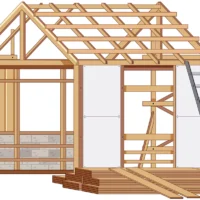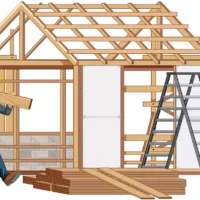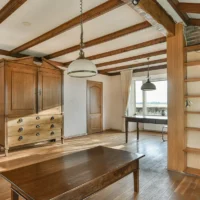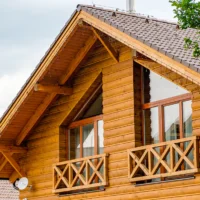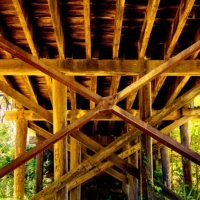Table of Contents
Introduction: The Beauty of Log Deck Railings
If you’re designing an outdoor space that blends naturally with the surrounding environment—especially in mountain or forest settings—log deck railings are an ideal choice. Whether you own a cabin, lodge, or a rustic-style home, log railings bring warmth, charm, and timeless appeal that other railing materials simply can’t match.
What Makes Log Deck Railings Ideal for Rustic Designs?
Log deck railings are made from whole logs or log-milled wood, which gives them a distinctly rugged and organic look. Unlike sleek metal or glass railings, log railings emphasize natural texture and raw beauty—perfect for settings where you want to feel connected to nature.
These railings complement the rustic architecture of log cabins, timber-framed homes, and countryside lodges. They’re not just decorative; they’re part of the structure’s character.
The Natural Appeal of Log Railings in Outdoor Spaces
There’s a reason log railing is commonly seen in national parks, forest lodges, and mountain retreats. Their earthy look helps outdoor spaces feel grounded, welcoming, and authentic. Whether you’re enjoying a sunrise coffee or an evening by the fire pit, a log deck railing frames your view without stealing attention from it.
How Log Railings Enhance Cabins, Lodges, and Nature-Inspired Homes
Log deck railings act as a design bridge between the indoors and outdoors. For cabins and lodges, they mirror the raw materials of the home’s architecture. Instead of disrupting the natural setting, they enhance it—making your outdoor space feel like an extension of the forest or mountains around you.
What Are Log Deck Railings?
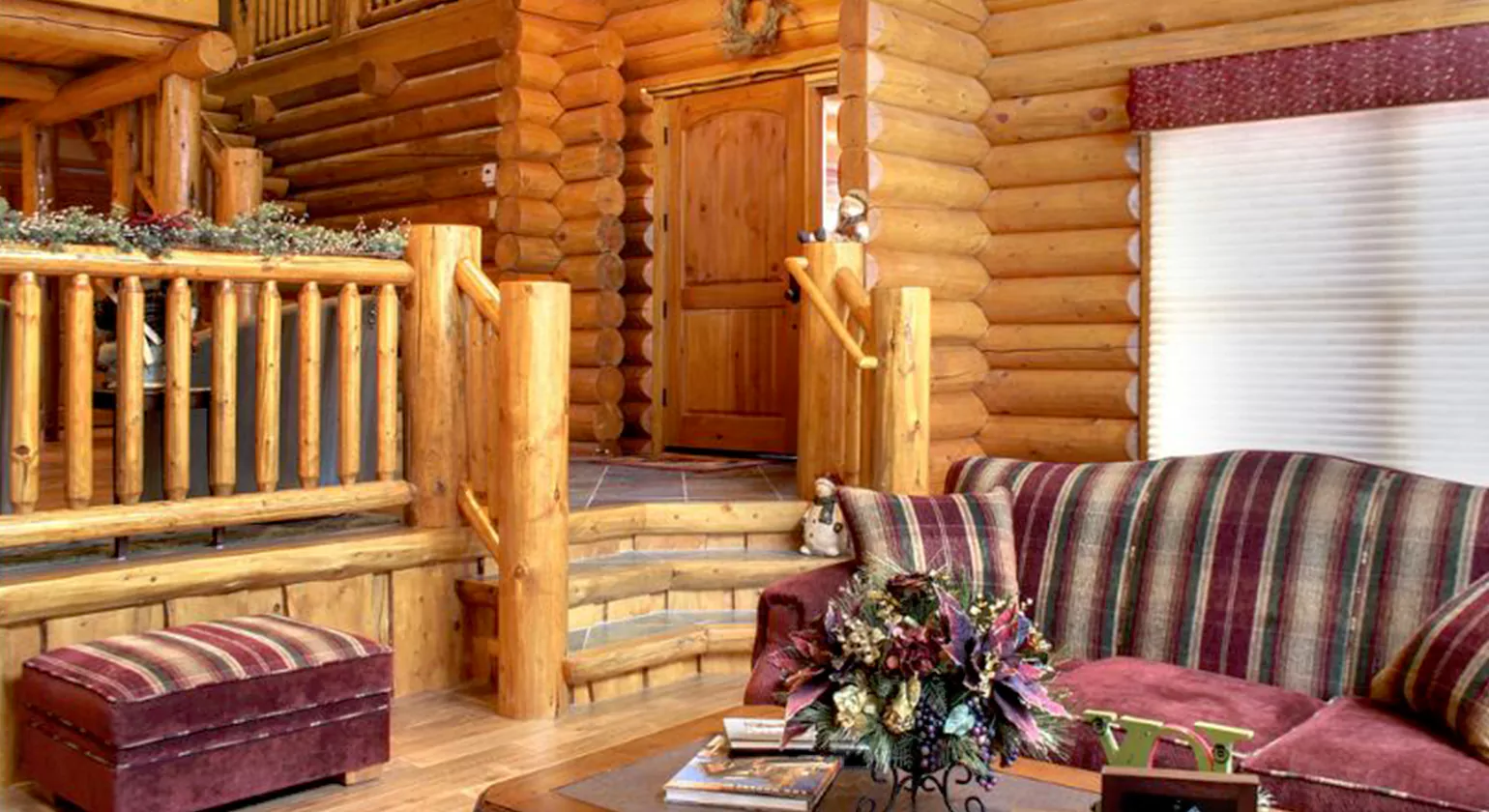
Defining Log Deck Railings
Log deck railings are rail systems crafted from round, half-round, or milled wood logs. They typically include a top rail, bottom rail, vertical spindles (or balusters), and supporting posts. You’ll often find these made from cedar, pine, or hickory—woods prized for their durability and natural resistance to decay.
How Log Railings Differ from Traditional and Modern Railing Types
Most modern railings focus on minimalism or metal accents. Log railings, on the other hand, highlight texture, grain, and craftsmanship. Compared to vinyl or aluminum railings, they offer a much thicker, more tactile profile that feels handcrafted and solid under your hand.
They also age differently developing a patina and weathered finish that adds character over time, rather than looking worn out.
Ideal Locations for Log Deck Railings (Decks, Porches, Balconies)
While log deck railings are most popular on wraparound decks and elevated porches, they’re also great for interior staircases, balconies, and even entryways. If your goal is a cohesive rustic design, using log railings both inside and out helps unify the aesthetic.
Top Benefits of Log Deck Railings
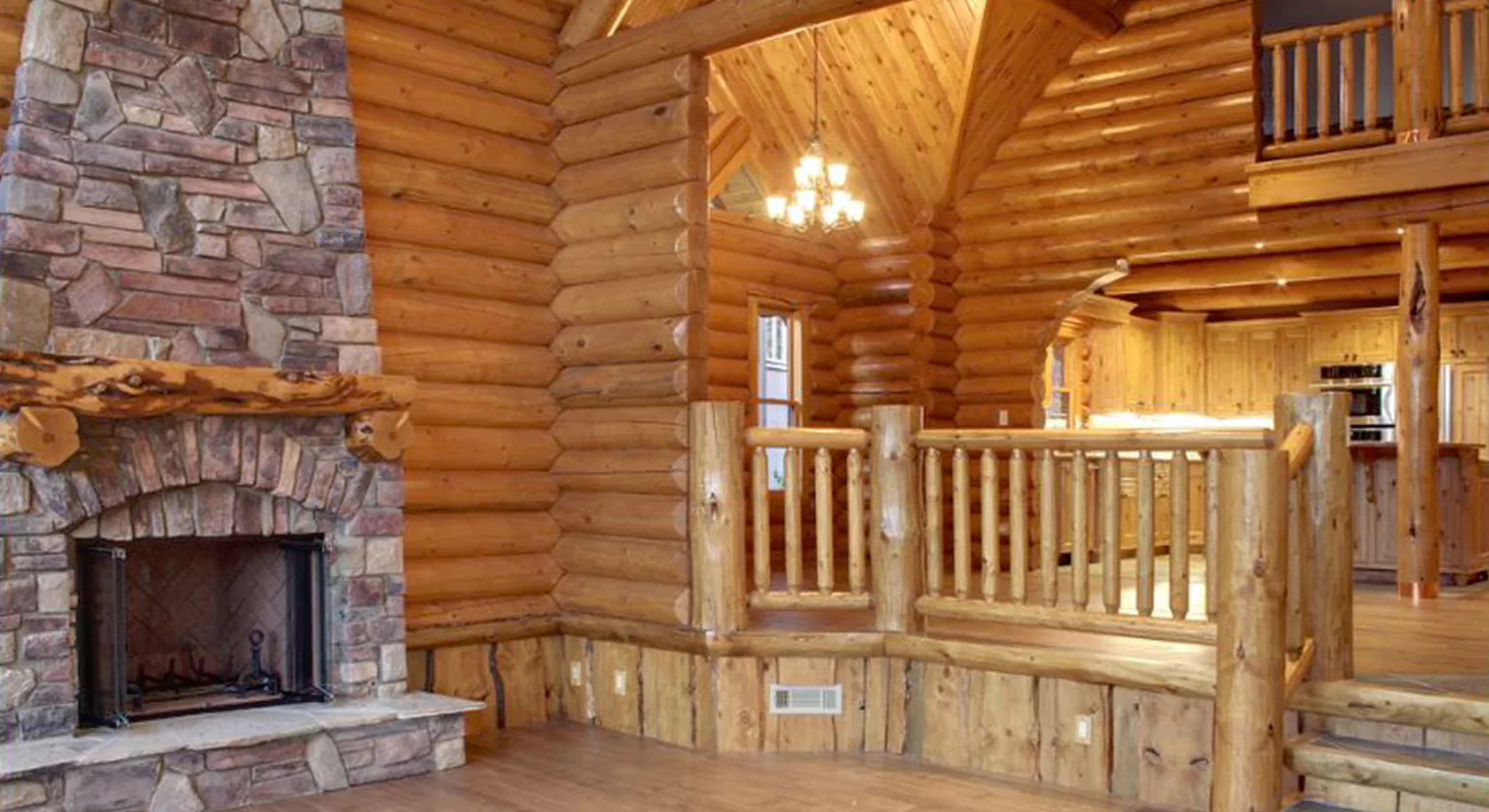
Adding Rustic Charm and Warmth to Outdoor Spaces
Log deck railings create an inviting, storybook look that evokes images of cozy cabins, peaceful retreats, and scenic wilderness. Their natural texture and organic shapes make your deck feel like part of the environment rather than something separate from it.
Durability: Why Log Railings Stand the Test of Time
When properly sealed and maintained, logs are incredibly durable. Cedar and hickory, for example, have natural oils that repel insects and moisture. Log railings can withstand years of wind, rain, and sun—especially in mountain climates—making them both beautiful and tough.
Customization for Unique Home Styles
One of the biggest advantages of log railings is that they can be custom-built to your exact preferences. Choose from traditional single rails, double tops, or even mix-and-match styles with black bar or rebar accents for a more modern twist.
Boosting Property Value and Curb Appeal
A well-built log railing isn’t just functional—it adds visual interest, craftsmanship, and curb appeal that buyers notice. It’s a small architectural detail that makes a big impression, particularly for homes in scenic or rural areas.
Popular Log Deck Railing Styles and Designs
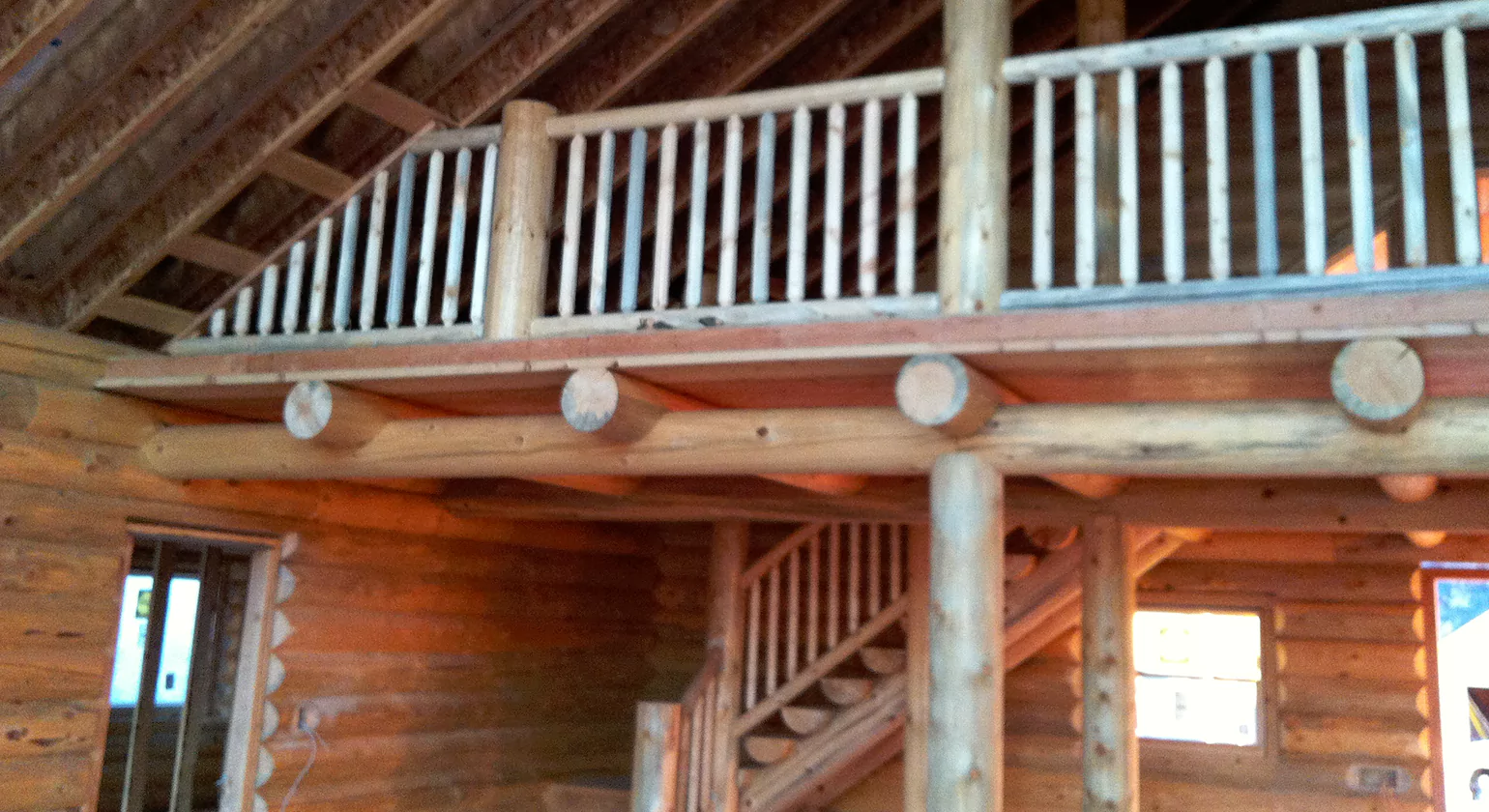
Choosing the right log deck railing style not only enhances the safety of your outdoor space but also defines its character. From classic looks to bold, rustic-industrial blends, here are the most popular design options that suit any cabin, lodge, or nature-inspired retreat.
Classic Cedar Log Railings
Cedar remains a top choice for log railings—and for good reason.
1.Natural Resistance to Decay & Insects
Cedar is naturally rot-resistant and contains oils that repel bugs, making it ideal for decks exposed to the elements. It holds up well in both humid and dry climates, reducing the need for frequent treatment.
2.Wood Grain & Color Tone Variations
Cedar railings showcase beautiful grain patterns, knots, and warm reddish tones that complement log homes perfectly. Over time, they can develop a soft silvery hue when left untreated or retain their color with staining.
Traditional vs. Double Top Rails
The difference between traditional and double top rail designs goes beyond aesthetics.
Aesthetic and Functional Differences
Traditional rails feature a single top beam, offering a clean, minimalist look. Double top rails, on the other hand, add dimension and strength—plus a place to rest a drink or lean on comfortably. Double rails are ideal for larger decks or those with scenic views where you want a bolder presence.
Black Bar and Rebar Railing
Blending rugged metal with natural logs, black bar or rebar railings are gaining popularity.
Incorporating Industrial Flair with Rustic Wood
This hybrid design features vertical or horizontal black metal bars between log posts and rails, creating a bold contrast. It’s a great choice for homeowners seeking a modern rustic vibe, especially for mountain homes with contemporary features.
Hickory Spindle Styles
Hickory spindles are another visually rich option for those seeking a historic or heirloom-style look.
Strength and Rugged Beauty for Historic Designs
Hickory is incredibly dense and strong, making it perfect for railings that span longer distances or need to withstand heavy use. Its natural color variation and bark-on texture provide a raw, authentic look that’s hard to replicate with other woods.
Choosing the Best Wood for Log Deck Railings

Your choice of wood significantly affects not only the look but also the durability, cost, and maintenance of your log deck railing.
Cedar: Lightweight, Rot-Resistant, Aromatic
Cedar is the most popular choice for a reason. It’s lightweight and easy to install, making it ideal for DIYers. Plus, its natural oils deter insects and mold. As it ages, cedar develops a graceful, weathered look that many homeowners love.
Pine: Affordable and Easy to Work With
Pine is a budget-friendly option, often used in log railing kits. It’s soft and easy to cut or shape, making it a go-to for customized designs. However, it does require regular sealing to prevent moisture damage and prolong lifespan.
Hickory: Durable and Heavy-Duty for Long Spans
Hickory is one of the hardest domestic woods and offers unbeatable strength. It’s ideal for decks that need long rail spans or extra structural integrity. While more difficult to work with, its longevity makes it worth the effort.
Tips on Choosing Wood Based on Climate and Usage
- Wet climates: Go for cedar or pressure-treated pine.
- Dry, high-sun exposure: Hickory holds color well and resists cracking.
- Heavy snow zones: Choose woods with dense grain for added load-bearing strength.
How to Choose the Perfect Log Railing for Your Deck
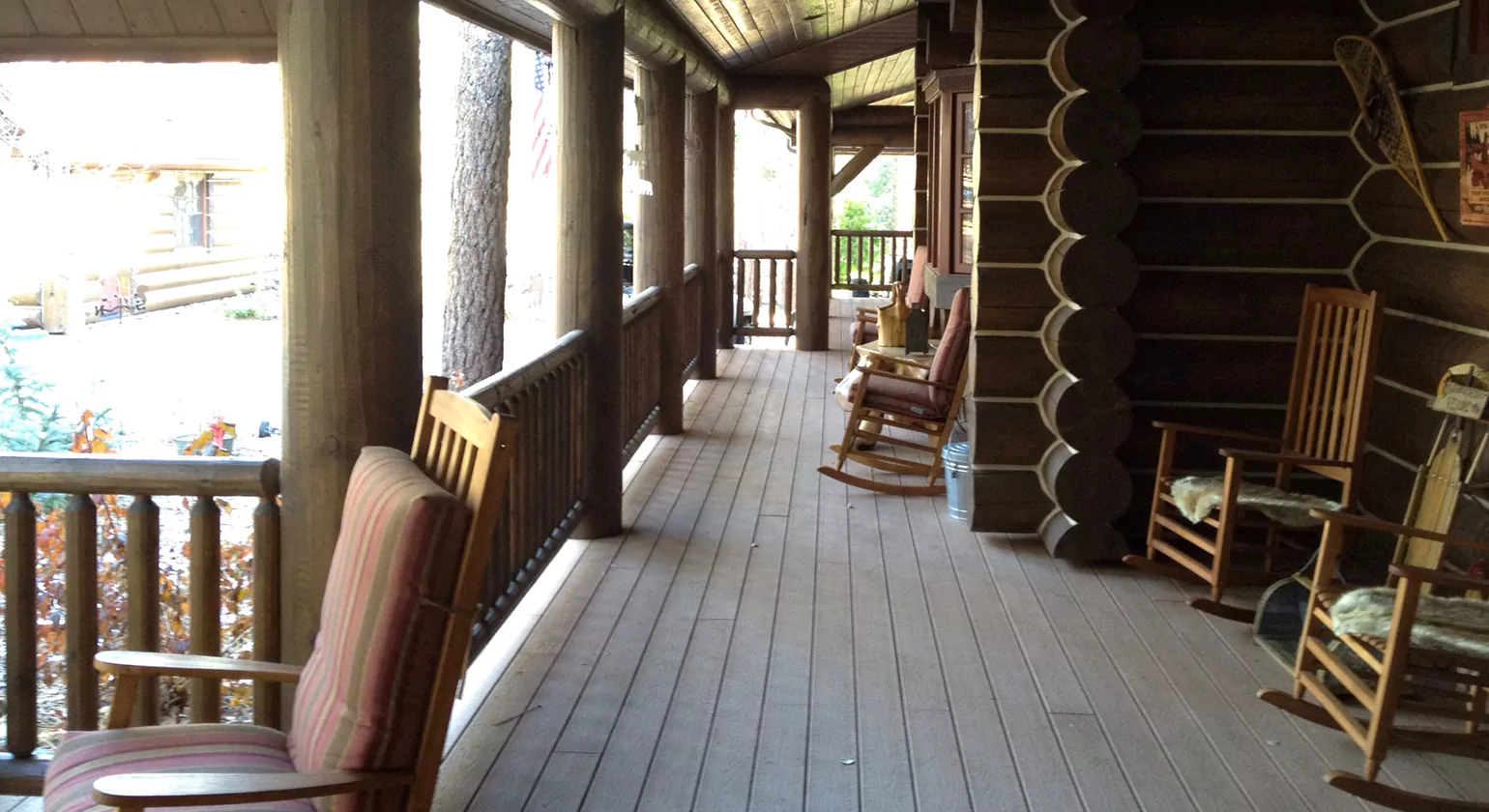
Now that you know the options, it’s time to match your railing with your deck’s layout and aesthetic goals.
Matching Railing Proportions to Your Deck Size and Layout
For smaller decks, choose lighter rail profiles like single-top rail cedar styles. Larger decks benefit from double-top rails or bold hickory posts that anchor the space visually.
Selecting Posts for Corners, Lines, and Stairs
- Line posts work between straight railing sections.
- Corner posts handle multiple directions.
- Stair posts should be angled and reinforced for safety.
Choosing the correct post type ensures your railing is structurally sound and visually seamless.
Design Tips for Multi-Level and Wraparound Decks
Multi-level decks benefit from consistent railing design, but slight variations—like a rebar accent on the upper level—can add depth. Wraparound decks should maintain symmetry to create flow from one area to the next.
Integrating Railings with Other Exterior Features
Tie your railing design to other architectural features:
- Match log stain with trim or shutters
- Echo railing metalwork in light fixtures or door hardware
- Choose wood types that complement deck furniture or pergolas
Step-by-Step Guide to Installing Log Deck Railings

Installing your own log deck railing is an achievable DIY project with the right tools and a solid plan. Whether you’re upgrading an existing deck or building from scratch, precision and patience are key to a safe and visually appealing result.
Tools and Materials You’ll Need for Installation
Before you begin, gather the essential tools:
- Measuring tape and pencil
- Torpedo level
- Chainsaw or cross-cut saw
- Power drill and 1/2″ drill bit
- Chop saw
- Lag bolts (6″, 3/8) and washers
- Safety glasses and gloves
- Clamps or sawhorses for stabilization
Make sure your railing kit or custom-cut pieces are on-site and labeled clearly for each section.
Measuring, Marking, and Cutting Posts Precisely
Start by measuring and marking the center and tail overhang of your posts—usually with an 8” overhang. Use your level to draw straight lines where you’ll cut. Secure the log on a stand or sawhorse and make your cuts carefully, ensuring consistency across posts.
Drilling Tenon Holes and Creating Notches
Drill two tenon holes per post: one approximately 5.25” from the bottom, and the second at around 30.75”. Always measure up from the notch center for accuracy. Then cut notches where the rails will fit—these should be debris-free and level with the deck for a tight fit.
Securing Posts to the Deck and Fastening Tenons
Fasten each post using a lag bolt through the pre-drilled hole into the deck frame. Once secure, insert the tenons of the top and bottom rails into the post holes. Use exterior wood screws to hold them firmly in place. Check alignment with a level after each section.
Essential Safety Tips and Expert Finishing Techniques
- Wear eye and hand protection when cutting and drilling.
- Use clamps to stabilize logs during sawing.
- Apply wood glue or construction adhesive in notches for added grip.
- Sand rough edges for a polished look.
- Seal exposed cuts to prevent moisture damage.
Custom vs. Pre-Assembled Log Deck Railings

Choosing between custom and pre-assembled log deck railings comes down to project complexity, budget, and personal preference. Both have distinct advantages depending on your needs.
Advantages of Custom Milling for Perfect Fit and Finish
Custom log railings are tailored to your exact deck dimensions, ensuring a flawless fit. You can select unique wood types, post shapes, and spindle spacing to match your vision. It’s ideal for uneven terrains, custom homes, or multi-level decks.
Quick and Easy Pre-Assembled Kits for DIY Projects
Pre-assembled railing kits save time and labor. These ready-to-install sections come with uniform spacing, tenons already cut, and easy-to-follow instructions—making them perfect for first-time builders or weekend warriors.
When to Choose Professional Installation Over DIY
Consider hiring a professional if your deck is:
- Multi-tiered or unusually shaped
- Located on a slope or uneven surface
- Requiring permits or structural reinforcement
A pro ensures everything is up to code and built to last, especially in challenging layouts.
Budget and Timeline Considerations
- Custom railing tends to cost more but offers a lifetime fit and aesthetic.
- Pre-assembled kits are more affordable and faster to install.
- Factor in tools, time, and potential adjustments when comparing total costs.
Log Deck Railing Maintenance and Care Tips

Proper maintenance ensures your log deck railing looks great and lasts for decades. Exposure to sun, snow, and moisture makes regular care essential—especially in climates with harsh winters or rainy seasons.
Seasonal Inspection and Maintenance Checklist
- Spring: Look for cracking, mildew, or loose fasteners.
- Summer: Re-seal if wood appears faded or dry.
- Fall: Clear debris between spindles to avoid moisture buildup.
- Winter: Check for snow accumulation and ice damage.
Inspect all connections and re-tighten screws as needed to prevent wiggling or sagging.
Best Sealants, Stains, and Protective Coatings for Longevity
Choose oil-based stains or clear sealants with UV protection to preserve the wood’s color and shield it from sun damage. Water-repellent finishes are especially useful in rainy or snowy areas. Reapply every 2–3 years depending on exposure.
How to Clean Log Railings Without Causing Damage
Use a soft brush and a mild wood cleaner or diluted dish soap. Avoid pressure washers as they can strip finish or damage soft woods like pine. Rinse gently with a hose and allow it to dry fully before applying any treatments.
Preparing Log Railings for Winter (Snow, Moisture Protection)
- Apply a fresh coat of sealant in early fall.
- Clear snow off regularly to avoid prolonged moisture exposure.
- Ensure the deck surface allows for water runoff.
- Consider covers or tarps if your deck is rarely used in winter months.
Sustainable and Eco-Friendly Log Deck Railing Options

As homeowners grow more environmentally conscious, the demand for sustainable log deck railing has risen. Thankfully, there are multiple ways to reduce your ecological footprint without sacrificing beauty or durability.
Sourcing FSC-Certified Wood for Sustainable Projects
Look for railing suppliers that offer FSC-certified wood—lumber harvested from responsibly managed forests that meet rigorous environmental and social standards. Using FSC wood ensures that your project supports forest preservation, biodiversity, and ethical labor practices.
The Value of Reclaimed and Recycled Materials
Reclaimed wood from old barns, cabins, or industrial structures adds a unique, weathered charm to your railing. Not only does it reduce demand for new lumber, but it also recycles history into your outdoor design. Recycled metal, like rebar or black bar railings, can add a rustic-industrial touch while supporting eco-conscious construction.
Eco-Friendly Finishes: Low-VOC Stains and Paints
Supporting Local Timber Producers for a Green Future
Buying from local sawmills or regional timber producers reduces the carbon footprint of shipping materials long distances. Supporting local businesses also promotes sustainable forestry practices and strengthens your community’s economy—making your railing both beautiful and meaningful.
Real-Life Inspiration: Log Deck Railing Projects

Visual inspiration can help you envision how log railings will look in your space and encourage creative design choices.
Showcasing Log Deck Railing Designs in Rustic Homes
Cabins and mountain homes benefit immensely from handcrafted log railings. Whether it’s a lakefront retreat or a wooded getaway, these railings add cohesion to the natural surroundings and boost outdoor living appeal.
Beautiful Before & After Deck Transformations
Swapping out worn or outdated railings for custom log styles creates stunning visual impact. Before-and-after photos showcase how a simple change can modernize and warm up a deck instantly.
Ideas for Blending Log Railings with Modern Architecture
Yes, log railings can work in modern homes too. Combine sleek metal spindles with cedar rails or choose minimalist log posts to create a rustic-modern fusion that feels balanced and stylish.
Conclusion
Log deck railings are more than functional safety features—they’re an opportunity to add warmth, character, and natural beauty to your outdoor space. With the right design, wood type, and installation method, you can create a railing that lasts for decades and reflects your style. Whether you prefer classic cedar, rugged hickory, or a reclaimed rustic vibe, the possibilities are as wide as the great outdoors.
Know More>>>Timber Frame Cottage Everything You Need to Know
FAQ's
1. What is the best wood for log deck railings?
The best woods for log railings are cedar, pine, and hickory. Cedar is popular due to its natural resistance to decay and insects. Hickory offers maximum strength and durability, while pine is budget-friendly and easy to work with.
2. Are log deck railings safe and up to code?
Yes, when installed properly, log railings can meet building code requirements. Make sure your railing height, spindle spacing (typically under 4”), and secure fastenings meet local safety standards.
3. Can I install log deck railings myself?
Absolutely. Many homeowners choose DIY log railing kits. With basic tools and a step-by-step guide, you can install log railing posts and rails securely. For complex decks or custom fits, professional installation may be better.
4. How do I maintain log deck railings?
Maintenance includes seasonal inspections, applying weather-resistant sealants, and cleaning the railings gently with mild soap and water. Re-staining every 1–2 years helps protect against moisture and UV damage.
5. Are log railings weather-resistant?
Yes, especially when made from rot-resistant woods like cedar and sealed properly. They’re built to endure rain, snow, and sunlight, but regular maintenance will extend their life and appearance.
6. Can I mix log railings with modern design elements?
Definitely. Many homeowners mix log rails with black metal balusters or glass panels for a rustic-modern aesthetic. This adds contrast and creates a stylish, updated look without losing its natural charm.
7. How to stain log home style deck railings?
To stain log home-style deck railings, clean the surface thoroughly, let it dry, and sand any rough areas. Apply a high-quality exterior wood stain using a brush or sprayer, working with the grain. Allow proper drying time between coats. Finish with a sealant for added protection and durability.
8. What kind of logs to use for deck railings?
Cedar, pine, and fir are the most common logs used for deck railings due to their durability, natural beauty, and resistance to insects and decay. Cedar is especially popular for its weather resistance, while pine and fir offer affordability and strength. Choose kiln-dried, treated logs for long-lasting performance outdoors.



